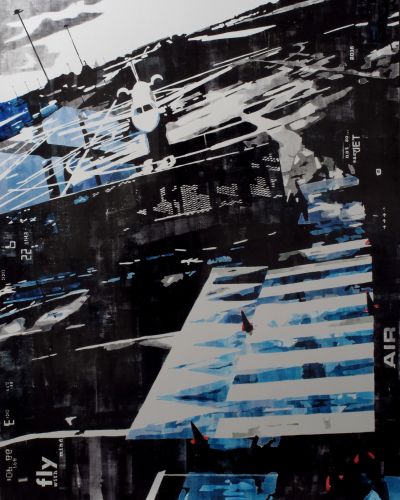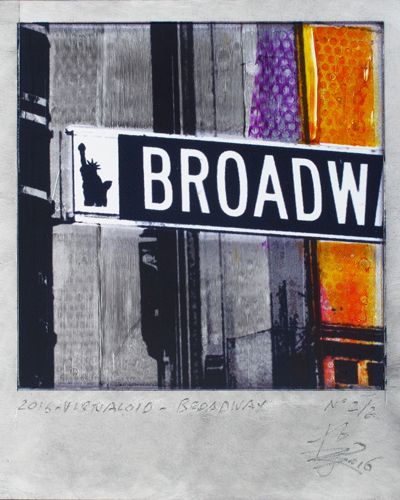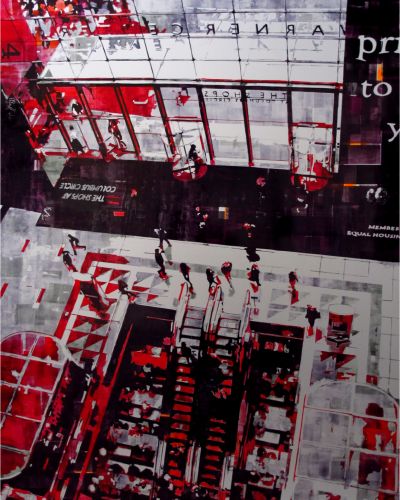Fabrizio Bellanca was born in Rome in 1968. He received his diploma in 1987 from the G. Terragni High School Specialising in Artistic Education in Como. He graduated from the Graphic Design Program at the Istituto Superiore di Grafica Pubblicitaria del Castello Sforzesco, in Milan, in 1991. In his first artistic research, starting in 1989, he applied techniques deriving from metropolitan graffiti and writing onto canvas. They are characterised by strong colours and abstract forms. His love of e... [Continue reading]
![]()
Fabrizio Bellanca Fab
Italy
Atelier of Fabrizio Bellanca Fab



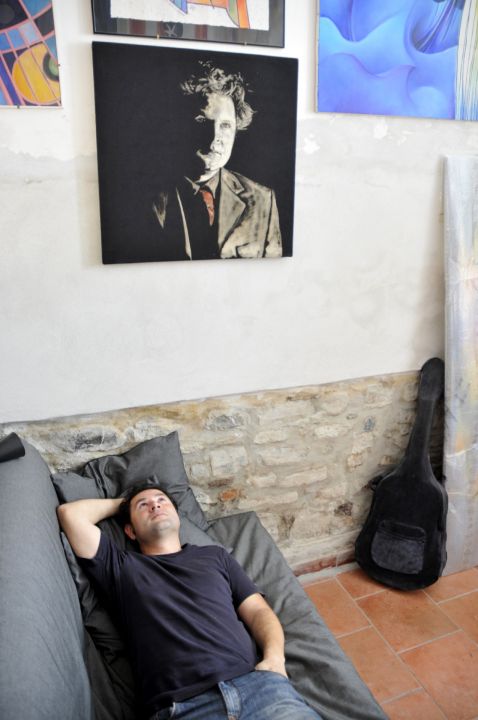
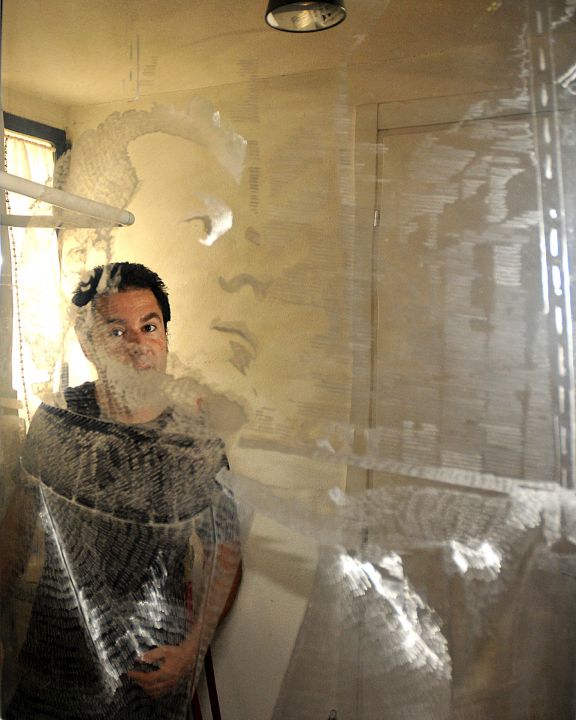





















All artworks by Fabrizio Bellanca Fab
Information about Fabrizio Bellanca Fab
Fabrizio Bellanca was born in Rome in 1968. He received his diploma in 1987 from the G. Terragni High School Specialising in Artistic Education in Como. He graduated from the Graphic Design Program at the Istituto Superiore di Grafica Pubblicitaria del Castello Sforzesco, in Milan, in 1991. In his first artistic research, starting in 1989, he applied techniques deriving from metropolitan graffiti and writing onto canvas. They are characterised by strong colours and abstract forms. His love of experimentation and of new materials led him to use resin in his work and applied liberally it created an extremely shiny, wet look that exalted the colours. Towards the end of the 1990s the artist began his investigation into action painting, working with oil paint on textured surfaces. His works ranged from figurative to abstract, but the true revolution in his work came in 2004 when he “discovered” steel plates as a medium; he began working on this new material with a Dremel™ miniature rotary tool, utilising stone and diamond-wheel accessories, creating effects that are surprisingly similar to those of a pencil. His subjects are people, places and buildings, almost always on a large scale.
His continual experimentation carried on into music when he accompanied the group Blue Silk in artistic/musical performances in which the sound of the rotary tool engraving the steel plate, accompanied by harp and electric guitar, created melodies. Presently, the artist continues his work on steel and aluminium plate, applying printing inks over colours for glass and Letraset™ transferable elements. Fabrizio Bellanca lives and works in Como, where he is the owner of the graphic design studio “Fab”, a company focusing on corporate identity, graphics for print and website design.
2020
- Artresti domiciliari / Contagio leale - Mostra progetto di 7 artisti - Spazio Art Company Como
- Collaborazione con Axrt Gallery Avellino opere in permanenza
2019
- Interference - Mostra internazionale - San Pietro in Atrio a cura di Roberta Gonella - Como
- ” Virtualoid – Jump Back in the Future ” – Personale – Torino – Galleria Paola Meliga
2018
- Virtual VS Real LOVE Bi-personale con Marcello Grassi presso IAGA Gallery – Cluj Napoca – Romania
- Opere in permanenza presso Galleria Urban Art – Tourrettes sur Loup – France
- Vision Urbaines/ Urban Visions Bi-personale con Pietro Bellanca – Espace Rose de Mai – La Colle sur Loup – France
- “Ragione e Sentimento” – Collettiva – Catalogo – Lenno (CO)
2017
- Virtualoid/Soulscape – Personale presso “The Art Company” – Como – Video
- Gallery sweet Gallery “#naturaistantanea” partecipazione con Roberta Marone con una installazione specific site – Catalogo a cura di Elena Isella
2016
- Anime urbane – Bi-personale con Marcella Chirico – Villa Sormani – Mariano Comense ( Co) – Catalogo
- Partecipazione alla Berlin Maker Faire – 30 settembre/1 ottobre Berlino – Germania
2015
- Personale “YOUrban Soul / Anima Urbana” a cura di Elena Isella – Ex Chiesa di San PIetro in Atrio, Como – Catalogo e Video
Progetto “Open artelier”First Edition – 34 atelier open from 1st may to 31st october in Como – Map realized in 55.000 copies- Project, concept and realization by Fabrizio Bellanca. Patrocinio di Padiglione Italia Expo 2015, Sistema Como, Canto della Terra, lago di Como.
2014
- Urbanscapes – Blendage Gallery – Como
- Affordable Art Fair – Singapore 20/23 Nov 2014 – Villa del Arte Gallery Barcelona
- Asia Contemporary Art Fair – Hong Kong oct 2014 – Amstel Gallery London
2013
- Boston – Como “Boston-Como More than an Art Exchange” 18luglio/18 agosto 2013 – Broletto/ San Pietro in atrio/ Spazio Natta/ Camera di Commercio/ Galleria Lopez/ Galleria Lietti – Como
- Catalogo. A cura di James Hull e Carolina Lio
- Galerie Angle3 – Quimper (France)
- The Beat Goes On – Collettiva- Centro Congressi Medioevo – Olgiate Comasco
- Collettiva “7 Seven -Lussuria-(LUXURY) 25 maggio al 30 giugno – Ex Convento dei Francescani Neri – Specchia (Lecce)
2012
- Urbanscapes in Venice – Venezia 30 maggio/28 giugno – catalogo
- Collettiva “7 Seven -Avarizia”-Museo Arcos Benevento
- fino al 28 febbraio – 54° Biennale di Venezia – Torino – Palazzo delle Esposizioni a cura di Vittorio Sgarbi – Catalogo
2011
- 54° Biennale di Venezia – Torino – Palazzo delle Esposizioni a cura di Vittorio Sgarbi – Collettiva “7 Seven -Superbia (PRIDE) Museo Arcos Benevento – Catalogo
- “Imaginafiera” Reggio Emilia con Amstel Gallery
- ”Boston Vienna 2ways” Collettiva – Boston (USA) – Laconia Gallery
- “NY 13 x 13 “ Bellanca/Galvano – Collettiva – Ponte Tresa (Svizzera)
- Collettiva “7 Seven – L’accidia (SLOTH)” Villa Vannucchi – San Giorgio a Cremano (NA) – a cura di Roberto Ronca – catalogo
- “URBANSCAPES” – testi a cura di Luigi Cavadini – Wien (Austria)– Area53 Gallery
- Grand Opening AMSTEL GALLERY London
- ArteCremona Fiera 26-28 febbraio – Galleria AMSTEL GALLERY
- BAF – Bergamo arte Fiera 14-17 gennaio – Galleria AMSTEL GALLERY
- Collettiva “7 Seven” Villa Vannucchi – San Giorgio a Cremano (NA) – a cura di Roberto Ronca – catalogo
2010
- Collettiva HUMAN RIGHTS – a cura di Roberto Ronca – Rovereto (TN)
- Collettiva “Tie ART” Spazio Fitzcarraldo – Milano–
- “All ALuminium Art” – galleria IL TRAMITE – Como – Catalogo
2009
- Passo Carrabile – a cura di Julia Allerstorfer – Wien – Area53 Gallery “
- “Tie ART” progetto pubblico per Como
- Collettiva “Architettura e stati d’animo – a cura di Luigi Cavadini – Villa Imbonati – Cavallasca (Como)
- “Le stanze dell’Arte” caserme de Cristoforis – Como
2008
- Collettiva con il gruppo quartodecimo “Expo-2” – Villa Imbonati – Cavallasca (Como)
- Mostra Personale in San Pietro in Atrio- “Riflessioni dell’Anima” 1-15 Agosto 2008 – Como / realizzazione della stessa su piattaforma virtuale “Second life” in contemporanea
- Performance con i Blue Silk – Guitar Master Festival – Galliate (NO)
- Collettiva “IstantaneaMente” con il gruppo “Quartodecimo” presso “Ex-Ateneo” – Bergamo
- Personale “Centro Russo Ecumenico” – Marzo 2008 – Roma
- diverse Personali e Collettive realizzate su “Second Life” in diverse gallerie virtuali
- Performance “Fab2-the last two” Viaggi Onirici Lievemente Organizzati – Roma
- Collettiva “Revolver” presso Centro Diurno del San Anna – Como
2007
- Collettiva “DIN DON D’ARTE” – Galbiate (LC)
- Collettiva “linguaggi contemporanei” – Cesano maderno MI
- Collettiva “Obsession o…” Centro Diurno del San Anna Como
- Personali realizzate su “Second Life” in diverse gallerie virtuali: “ Double face”, “Okkupazione artistica” “Ticosa 2006
Collettiva presso “Max Trezzi Arte” Lissone – Milano
2006
- Performance con i blue silk “Contemporanea IV” como
- Personale presso “Spazio ESP” Como – Catalogo in Galleria – performance con i blue silk – Ligornetto – Svizzera – MUSEO VELA
2005
- Performances con i Blue Silk “ARTISTI MISTI” – Monza
- Personale “Ex Ateneo” Bergamo Alta – Catalogo in Mostra
2004
- Mostra Collettiva – Palazzo Cesi – Acquasparta – Terni
- Mostra Collettiva – Fondazione Castellini
- Mostra Collettiva – Galleria Kamaver Kunsthaus – Lecco – “NEO ICONICA” – catalogo in galleria
2003
- Mostra personale in San Pietro in Atrio- “98/03 rewind/fast forward” Como
- Mostra personale Galleria Lopez – Como
- Partecipazione alla 2° Biennale di Tashkent – Uzbekistan
- Mostra Collettiva – Ontinyent – Valençia – Spagna
- Realizzazione Tondo per “Collezione Duilio Zanni”, esposta presso Broletto
2001
- Mostra personale presso “Marcellus Club” Circolo Culturale Asso – Como
- Mostra personale presso “031” Pub Artistico – Como
1998
- Partecipazione rassegna internazionale “Miniartextil ‘98”
- Mostra col gruppo “Nova Configurazione” presso San Pietro in Atrio “Amor Sacro Amor profano puttiniputtanepuntinipuntini” giugno-luglio 98
- Partecipazione al Concorso Internazionale per la progettazione di un manifesto per la Lega Italiana Lotta Contro i Tumori, Mantova – Palazzo Ducale (aprile 98) – Esposizione personale nell’ambito della manifestazione, all’interno del Palazzo Ducale – Mantova
1997
- Partecipazione alla Rassegna internazionale “Miniartextil ‘97”
- Rassegna artistica con il gruppo “Nova Configurazione” Pro-Vocation, Provocazione per Vocazione presso il Chiostro di S. Maria- Cantù (Co)
1995
- Personale presso Chiostrino di S. Eufemia- Como “Rassegna Artegiovane ‘95”
- Personale presso l’Associazione ludico-culturale ”Baratelli”- Cantù (Co)
Yourban Soul. In Praise of Cities by Elena Isella
One needs to have a garden, a day out, a second home, a vegetable garden, fresh air… all of this in order to escape from the metropolis you live in. True, and yet, big cities still seem necessary. Le Corbusier described the city as: “the point of contact for the active elements of the world” (Urbanisme, 1925), because the exchanges, comparisons and stimuli which present themselves in a big city are experiences which are certainly influential in one’s character development. The metropolises that Fabrizio Bellanca loves are New York, Boston, London, Barcelona and Milan, among others. First he observes them with a photographer’s eye, and then from the point of view of an artist. Bellanca’s works, revealing his past practise in typography and graphic design, move effortlessly between photography and painting, creating an identity of their own. The modern city, and large urban areas in particular, are the main protagonists in his work. He represents glimpses of details, architecture and the people who live in these metropolises. The strength of his works lies in their ability to be perfectly in tune with the eye of the viewer, regardless of his specific history, past or visual experience: the immediacy of communication is the trump card of Bellanca’s artwork. The shapes, superimpositions and small details create movement, which results in a kind of musical score in the entire composition. This is turn creates surprising and forceful effects, especially in the images with only a few colours, or even in those without colour, in which the subject is rendered exclusively in the play between black and silver, positive and negative.
Italo Calvino described the imaginary city of Zora like this: “a city that no one, having seen it, can forget. But not because, like other memorable cities, it leaves an unusual image in your recollections. Zora has the quality of remaining in your memory point by point, in its succession of streets, of houses along the street, and of the doors and windows in the houses, though nothing in them possesses a special beauty or rarity. Zora’s secret lies in the way your gaze runs over patterns following one another as in a musical score where not one note can be altered or displaced” (Invisible Cities, 1972). This pattern similar to a musical score is Zora’s secret – just like in Fabrizio Bellanca’s cities.
------------------------------------
I’m not sure if Fabrizio Bellanca was ever part of a group of graffiti artists, but I wouldn’t be surprised to find out he had registered some experience on Como’s city wall or on the walls of other cities. The way in which images were constructed in that specific time – now surpassed – was a source for the artist in developing of his original approach to painting. But, not without looking backwards. Because he was able to concentrate on the experiences and gains that have come out of Pop Art, and primarily upon the creations by Andy Warhol, a master who surpassed painting while remaining fully in it at the same time, who was innovative without inventing anything new, and who provided a totally fresh direction to the narrative aspect of art.
In the first place, both the materials and their support are interesting: instead of canvas, Fab uses sheets of aluminium that have already been used in typographic printing and are now recycled; and for colours he uses offset printing inks, both dense and transparent at the same time; and adds transferable characters by Letraset (letters, numbers and pictograms) used in the past by graphic artists and architectural studios.
With these tools he takes on the two approaches he favours in his artistic research: architecture and people. He looks for true genius in architecture, the building that embodies an innovative spirit and that is able to communicate, on its own, its expressive surfaces, volumes and voids, and the poetry that permeates it. It is here that he “plays with colours”, the colours that define the image and often render it absolute, displacing it from any known location, emphasising it for what it is and not for the space it is in. In the people he encounters he finds stimuli for a portrait that comes to life systematically, in which the figure is never betrayed, but rather scrutinised and rendered even more unique. Read and often built up like terrain – almost a topographic map made from contour lines – the figure vibrates and in its insubstantiality (or, sometimes contrarily, in its absolute physicality) it manages to be even more alive and intriguing than the subject it refers to. The “drawing” made by applying spatulas of colour, carefully and with restraint, define grids, sometimes wide, sometimes dense, that leave the spaces that are colour-free a descriptive-narrative function. The presence of what seem to be letters, numbers and words, add something, though still remaining abstract, like a distant voice, becoming coloured in the same way that colour becomes language, in an interesting cross-reference that breaks tradition with customary imagery.
The resulting images turn out to be so composite that they could get lost. But in the end, after close consideration, one realises that Bellanca entrusts the typographical inks with the same function that watercolourists assign to their watercolours. The image is formed bit by bit, with reservation, giving definition to, surprisingly, not the full areas, but the areas that are free of colour. This happens in those parts of the aluminium surface that remain clean, strong in their material nature and due to their reflectivity, which, spurred on by the coloured areas is able to render the plastic value of a work of architecture, or a face or body.
What can be said about themes that range over the world, from Como to Boston, to New York? They are a sign of the globalisation that renders everything the same, but also distinctly different, and that affects an artist in different ways (as can be seen in the different approaches to imagery) underlining once again the freedom that allows him to respond – also autonomously from himself – to the influences and stimuli of the times he is living in.
Luigi Cavadini
----------------------------
During a time when art transcends national borders and when artists become cosmopolitan explorers of culture. I am proud to announce that Fabrizio Bellanca of Rome is the founder of the exhibition “Boston-Vienna 2ways”. This journey into the heart of contemporary art of Boston and Vienna is an exchange between Europe and the United States that offers the opportunity to think about different identities and cultural heritages.
Bellanca’s work represents Italy’s experimental side, one for all the world to see. Many paintings portray cities like Boston, New York and Vienna, where the foundation of their architecture and the physiognomy of their people become a source of inspiration for the artist. He uses a combination of art and technology; in his works, metallic shadows and brushes of color give new birth to the consistency of reality.
The Consulate General of Italy in Boston supports this project, with the hope that contemporary Italian art will assume even a larger role in the international level. We will continue to promote new initiatives that strengthen the dynamic and innovative image of our country. I hope that the public will appreciate the exhibition and I would like to take the chance to give a warm welcome to all the artists that are participating.
Giuseppe Pastorelli
Console Generale d’Italia a Boston
----------------------------------------



















